The Sacred Bow: Archery in Religious Ceremonies
Archery in Religious Ceremonies
We all know that archery was vital for our ancient ancestors. It enabled us to hunt and wage war at a considerable distance. While this may not seem like that big of a deal to us today, the bow and arrow were significant technological breakthroughs when they first appeared. The importance of archery was surely not overlooked by the spiritual class in antiquity. As we shall see, archery has a spiritual aspect for many people across the globe and through the ages that continues to this day. The following article explores archery in religious ceremonies.
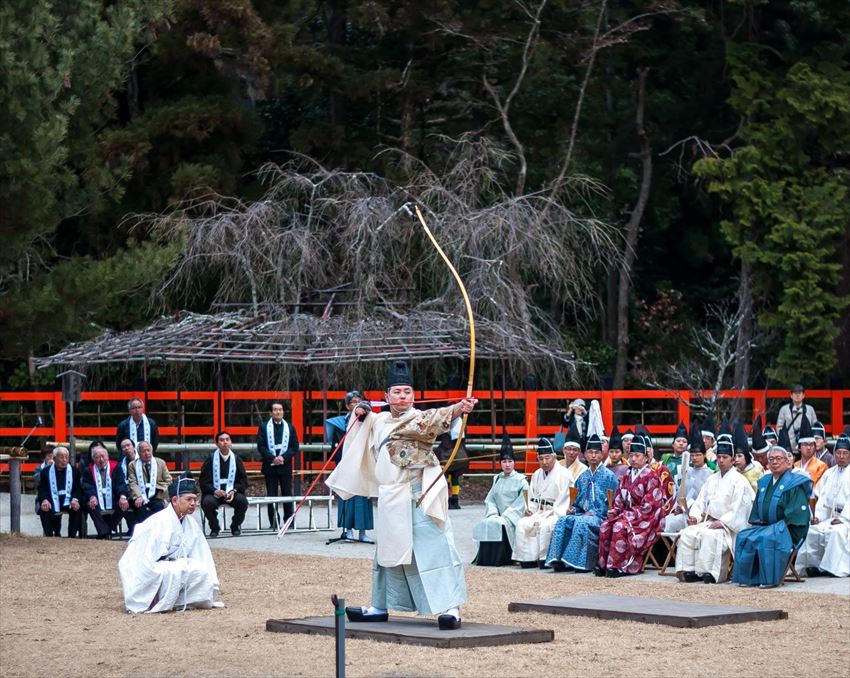
https://www.fun-japan.jp/en/articles/6727
Archery & Early Religion
We know archery is ancient. The Sibudu arrowheads for instance are dated to roughly 62,000 years ago! Interestingly enough, they were found in a cave, which ties into early religion, as we shall soon see.
But what about religion? How old is it? Well, it seems safe to say that religion, in one form or another is also very ancient. Unlike other animals, it seems that humanity seeks to find answers to many profound questions. What are we? How did we get here? What is the ultimate nature of reality? These deep and sometimes troubling questions are addressed through religious means.

Religion seems to be as old, if not older than humanity itself. Who knows, perhaps Neanderthals and other humanoid subspecies were also religious. For better or worse, religion has held a very important place in the lives of ancient humans, as it still does for many today.
It is no surprise then, that some of the first and oldest known writing is religious in nature. Also, there is tantalizing evidence that religion and ritual go back long before literacy. Let us examine the character of the shaman, some possible early rituals, and archery in religious ceremonies.
Archery & Ancient Ritual
Several ancient cave paintings or rock art were discovered in the 1870s. The first was discovered in 1875 in Altamira, Spain, and in 1879 in the Chabot Cave in the Ardèche Valley. Since then many cave paintings have been discovered in Western Europe. They include the following.
- Lascaux Cave, France: The Lascaux Cave complex in France contains several prehistoric paintings, some of which depict scenes of hunting with bows and arrows. These paintings are estimated to be around 17,000 years old.
- Altamira Cave, Spain: The Altamira Cave is renowned for its Paleolithic paintings, including depictions of animals as well as human figures with bows and arrows. These paintings are estimated to be around 14,000 years old..
- Chauvet-Pont-d’Arc Cave, France: The Chauvet Cave contains some of the earliest known cave paintings, dating back approximately 36,000 years. Among the detailed animal depictions are scenes that appear to show humans using bows and arrows in hunting.
- Cueva de la Pileta, Spain: This cave in Spain features Paleolithic paintings that include depictions of human figures using bows and arrows in hunting scenes. The paintings are estimated to be around 20,000 years old.
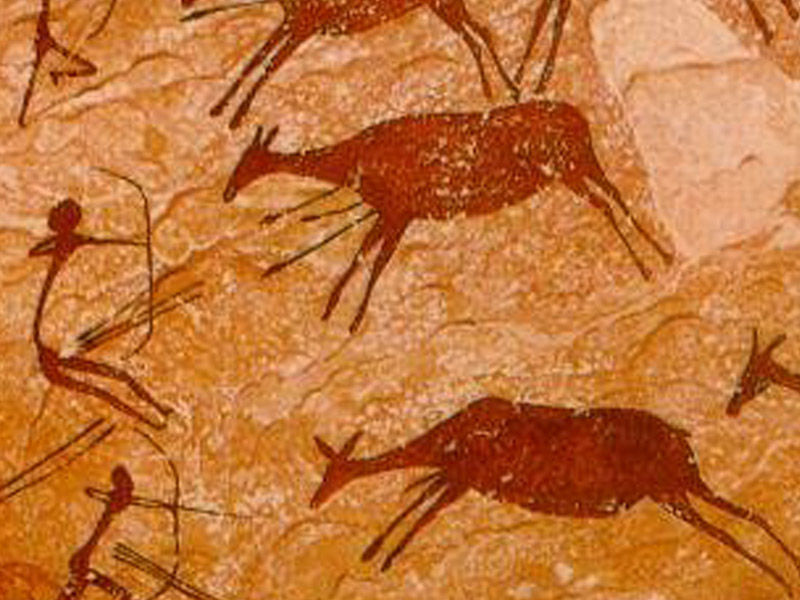
The Purpose of Cave Art
The purpose of ancient cave art, including whether it was ritualistic or religious, is a subject of ongoing research and debate among archaeologists and anthropologists. Some evidence does suggest ritualistic and religious significance in many cases:
Ritualistic and Religious Significance:
-
- Shamanistic Practices: Some researchers believe that cave paintings may have been created as part of shamanistic rituals. Shamans, who were believed to have the ability to communicate with the spirit world, might have used these images to connect with spiritual forces, seek guidance, or facilitate healing ceremonies. The symbolic and otherworldly nature of many cave paintings supports this theory.
- Spiritual Communication: In many cultures, cave systems were considered entrances to the spirit world or the underworld. Cave paintings could have been created to communicate with spirits or as offerings to appease supernatural beings associated with these realms.
- Ceremonial Sites: The placement of cave art deep within caves, often in areas that are challenging to access, suggests that the act of creating these images might have been part of elaborate rituals. The darkness and acoustics of caves may have added to the sensory and spiritual experience during these ceremonies.
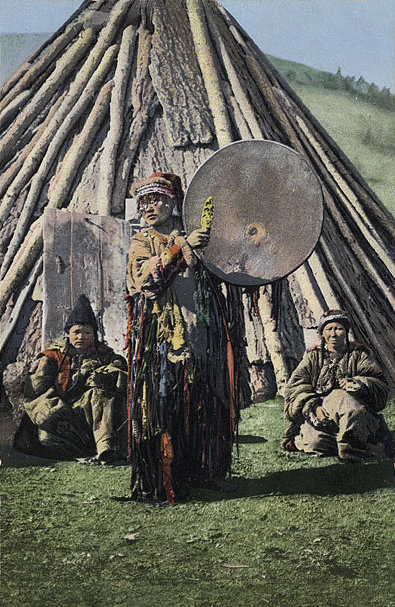
Narrative and Educational Purposes:
-
- Storytelling: Some cave paintings seem to depict sequences of events or narratives. These paintings may have served as a form of storytelling, passing down cultural knowledge, myths, and histories from one generation to the next.
- Educational Tools: In addition to storytelling, cave paintings could have functioned as educational tools. They may have been used to teach younger members of the community about important skills such as hunting techniques or the identification of animals and plants.
Social and Symbolic Functions:
-
- Social Bonding: The creation of cave art may have been a communal activity that fostered social cohesion. It could have brought people together in shared rituals or activities, strengthening bonds within the group.
- Symbolic Representation: Cave paintings often feature complex and symbolic imagery. These symbols might have represented concepts such as fertility, protection, or the relationship between humans and the natural world.
Some intriguing bits of possible evidence for the purpose of cave art being created as part of some sort of ritual is the fact that they are deep within caves. Some of the areas that have paintings are very tight and hard to access. If the art was meant to be displayed as art is today, for example, painting them deep within caves seems odd.

Secondly, some areas of caves (Lascaux Cave complex in France) have animals that have clearly been painted and repainted in the same manner, over the same image, multiple times. This, once again, does suggest a possible repeated ritual. [1]
This idea of influencing events (such as hunts) with “prescience magic” or “sympathetic magic” seems to be as old as humanity. A deep dive into these topics will remain outside the scope of this article. The basic idea most people are familiar with is that of the “voodoo doll”. You make a doll and get some hair or something physical from the victim’s body (this is black magic) and this magically binds the doll to the actual person. Affecting the doll in certain ways (poking it with needles, burning it) will cause a corresponding ill reaction in the intended victim.
Shamans & Trance
These cave areas may have also been used by the shaman. The idea of the shaman is also as old as humanity. The shaman interacts with the spirit world through altered states of consciousness. Other than clearly recognizable animals, ancient cave art is replete with strange creatures, mostly humanoid animal hybrids. This may be reflective of visual hallucinations while in altered states, or a depiction of the shaman himself, as he changes forms in the spirit world.
A possible shaman shapeshifter is the so-called “sorcerer”. It was found in the cavern known as ‘The Sanctuary’ at the Cave of the Trois-Frères, Ariège, France, made around 13,000 BCE. The image has largely been interpreted as a shaman performing a ritual to ensure a good hunt. [2]
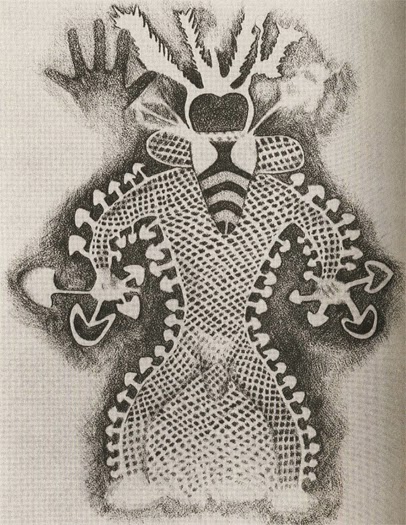
Another interesting image comes from a cave in Tassili n’Ajjer, Algeria. The figure is unusual, with what appears to be a large bee for its head, and mushrooms sprouting from all over its body. The image is considered by many researchers to have shamanic connotations, possibly hinting at altered states with the use of psychoactive mushrooms. [3]
Archery in Religious Ceremonies: Archery in Cave Art
Other than images of animals and possibly shamans in trance, ancient rock art prominently features archery. A successful hunt was life or death for early humans. Archery helped ensure a successful hunt. It can be said that archery has had a religious significance from the very earliest of times. Here are some cave sites that feature archery from around the world.
-
Lascaux Cave, France: These paintings are estimated to be around 17,000 years old.
-
Altamira Cave, Spain: The Altamira Cave is renowned for its Paleolithic paintings, including depictions of animals as well as human figures with bows and arrows. Estimated to be around 14,000 years old.
-
Bhimbetka Caves, India: The Bhimbetka Caves in India contain rock paintings that date back thousands of years.
-
Cave of Beasts, Namibia: This cave in Namibia features paintings believed to be around 25,000 years old. Among the various animal depictions, there are scenes showing human figures engaged in hunting with bows and arrows.
-
Chauvet-Pont-d’Arc Cave, France: Dating back approximately 36,000 years. Among the detailed animal depictions are scenes that appear to show humans using bows and arrows in hunting.
-
Cueva de la Pileta, Spain: This cave in Spain features Paleolithic paintings that include depictions of human figures using bows and arrows in hunting scenes. The paintings are estimated to be around 20,000 years old.
-
Tassili n’Ajjer, Algeria: The Tassili n’Ajjer region is known for its rock art, including paintings that portray scenes of archery and hunting. These paintings provide insights into the lives of ancient Saharan cultures.

In conclusion, the proximity of archery to spirituality and/or religion has strong evidence from the very earliest of times. This proximity and overlap between archery and religion continued from prehistory into more recent times. This connection has only strengthened in some cases. Also, the prevalence of archery in mythology attests to its significant influence on the stories humanity has told about itself.
For more on archery and mythology, check out our article on the subject here.
Archery in Religious Ceremonies: Shinto Rituals
Utilizing ceremonies or religious rituals to ensure successful hunts, good harvests, prosperity, and a host of other desirable outcomes continued on from the days of painting inside caves. This is very evident in several Shinto rituals that live on in Japan to this very day.
Archery in Medieval Japan held special cultural significance as it still does in the form of Yabusame (mounted archery) and kyudo.
A clear example is the Shinto ritual called Matoi Shinji, (or Omato) is held at Kifune-jinja Shrine in January in Togane, Chiba Prefecture. The ritual involves an archer shooting 12 arrows to divine the harvest for the year.
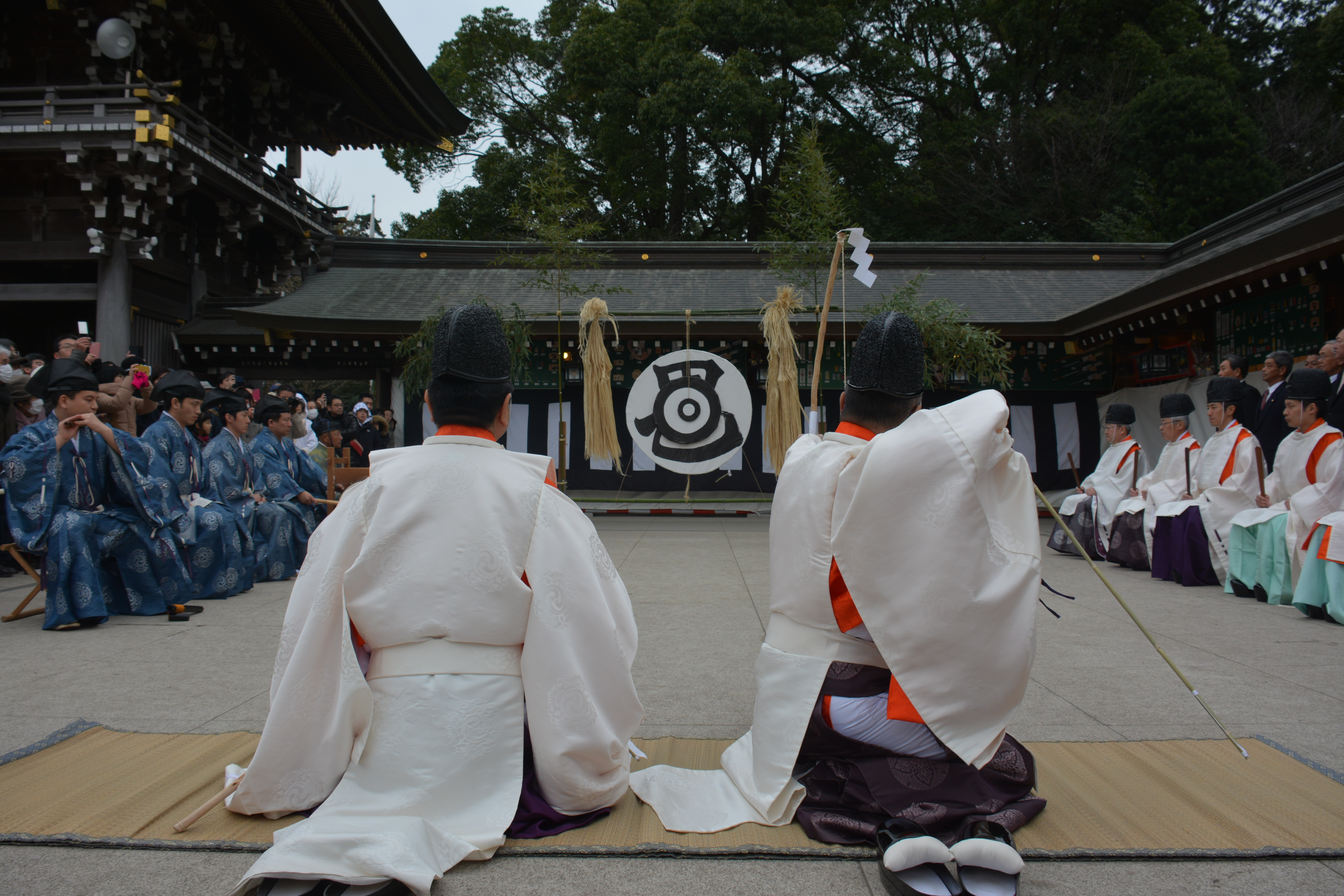
Another ritual, called Musayumisai is held on January 7 at Samukawa-jinja Shrine in Sagami, Kanagawa Prefecture. This ritual involves a Shinto priest shooting an arrow at a target with the character Oni (ogre or demon). The location of the arrow on the target is used to divine fortunes for the coming year.
The Tōshiya (通し矢, とおしや, “passing arrow”)
Another interesting archery event tied to religious ceremonies and Japan is the Tōshiya. It in and of itself is not specifically a religious ceremony or ritual yet it is connected very deeply with the Sanjūsangen-dō temple in Kyoto, Japan.
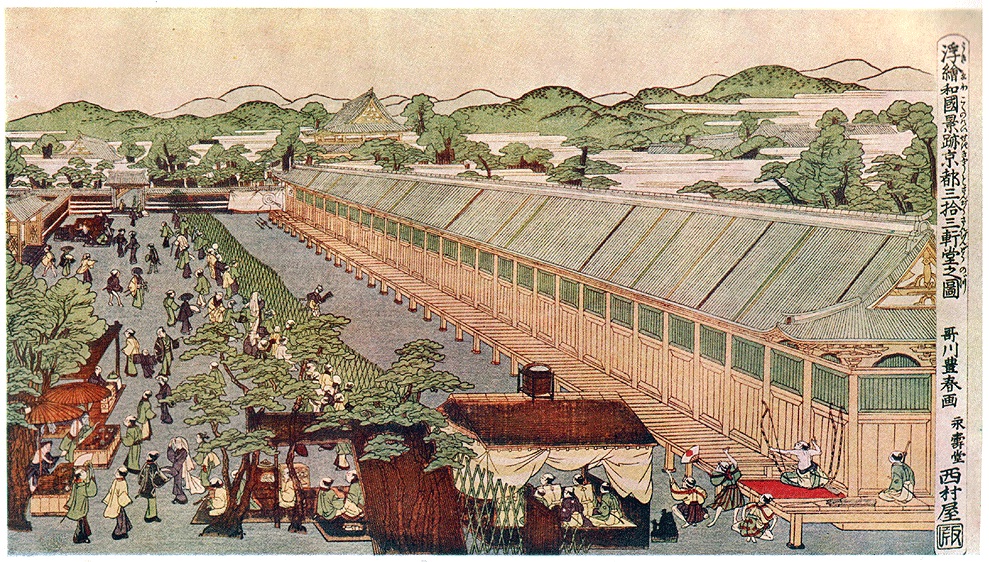
By Utagawa Toyoharu – 1. here, Public Domain, https://commons.wikimedia.org/w/index.php?curid=2550327
Back in 1606, a samurai named Asaoka Heibei was said to have shot 51 arrows swiftly one after the other down the length of the temple. This feat apparently encouraged other archers to shoot down the length of the side of the temple and an archery contest evolved over the years. [4]
The length down the one side of the temple from where the archer shot and the location of the target was 120 meters. There are only 5 meters of clearance under the eaves of the building, so this involves some precision long-distance shooting. The contest drew increasingly large crowds and fierce competition. Four distinct events evolved over the 255 years the contest was held (1606-1861)[5]
- The Hyaku-i (百射, ひゃくい, lit. one hundred shots) Most shots on target from 100 arrows
- The Sen-i (千射, せんい, lit. one thousand shots) Most shots on target from 1000
- The Hiyakazu (日矢数, ひやかず, lit. Number of arrows in a day) A contest for juveniles. Most arrows on target at 60 meters during a 12-hour period
- The Ōyakazu (大矢数, おおやかず, lit. great many arrows) As many arrows on target in a 24-hour period.
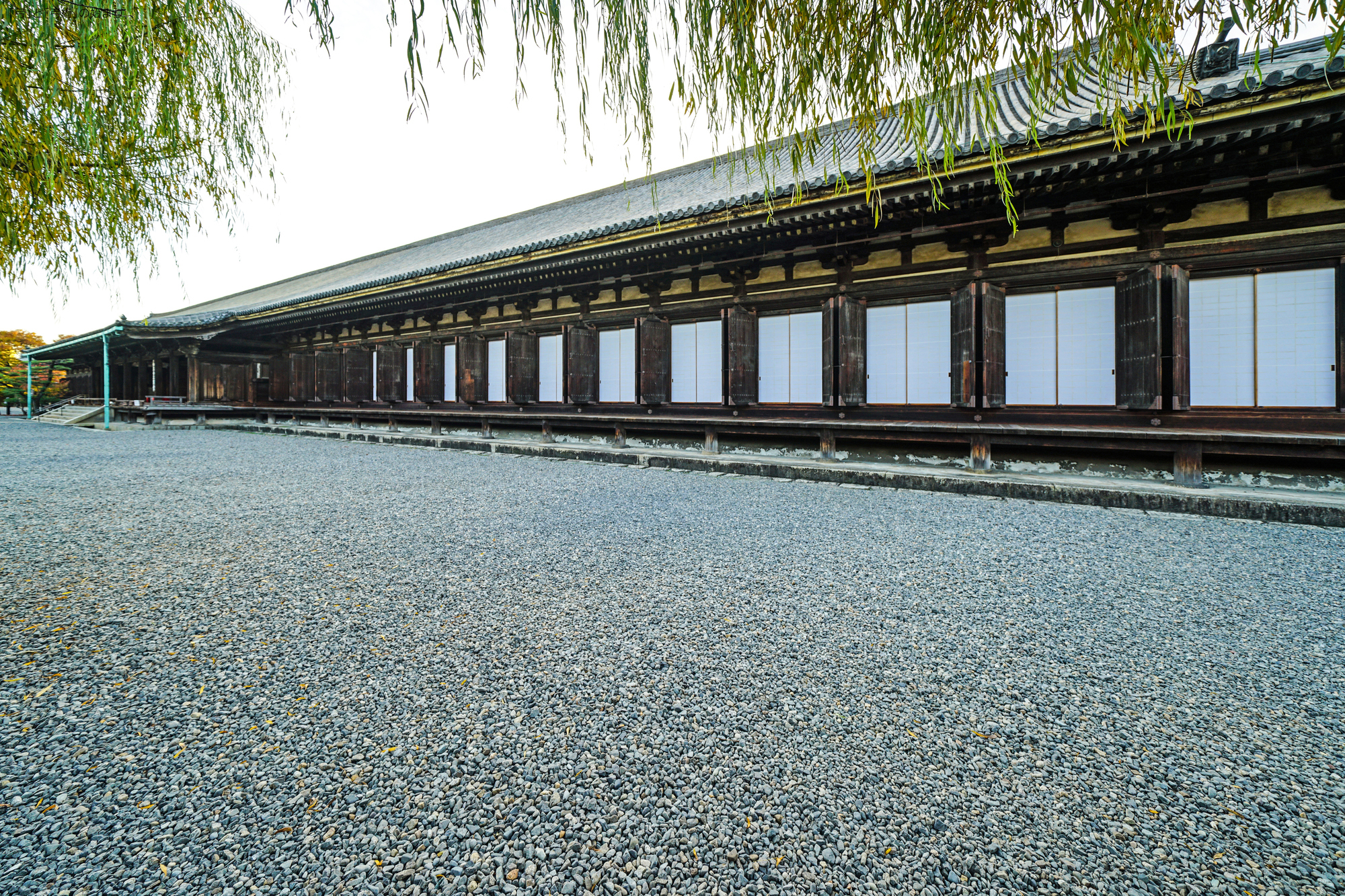
Archery Ceremonies in Ancient China
Chinese culture and history are ancient and feature archery in many aspects, from hunting and warfare to mythology and folklore as well as philosophy, ceremonies, and rituals. With Chinese writing dating back approximately 3500 years [6], many ancient texts illustrate the connection between archery, magic, divination, and early religion.
Some noteworthy fragments of folklore come to us from the Western Zhou Dynasty (1027–771
BCE) and refer to the mythical archer Yi. In one of these early myths, the world is plagued by various monsters. However, the monsters have their match in an archer, Yi, who heroically defeats the monsters with some archery prowess.
“The Heavenly Emperor had pity on mankind, and so he gave his servant, the
Archer Yi, a cinnabar-red bow and wooden fowling arrows with the power to defeat monsters”. [7]
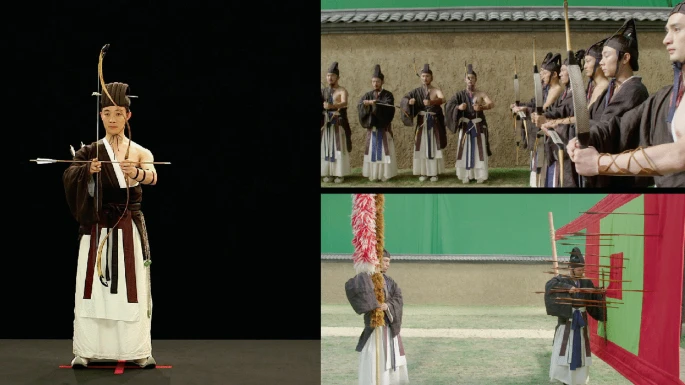
Archery in Confucian Rites
Confucius (Kong Fuzi, Chinese: 孔夫子, lit. ’Master Kǒng c. 551 – c. 479 BCE) was a philosopher in ancient China whose ideas and writings greatly influenced Chinese culture for millennia. Although his teachings may be regarded as secular, there are those who propose that most of the context of his teachings is of a worldview that is religious.[8] Confucious seems to have been well acquainted with archery, as he uses archery-related metaphors in his teachings. Furthermore, the so-called “Six Arts” which were a foundation for education in ancient China became an integral part of Confucianism. One of the six emphasized arts was indeed archery.
The Six Arts
The Six Arts [“liù yì” (六藝) ] were important for the cultivation of character as well as establishing social status, especially amongst the nobility during the Zhou dynasty (1122–256 BCE). Those who established a certain level of mastery of all of the Six Arts were said to attain a certain level of perfection, becoming a junzi. The term may be translated as “noble man”, “superior man” or more commonly as “gentleman”. The Six Arts are as follows:
- Rites (禮)
- Music (樂)
- Archery (射)
- Chariotry or Equestrianism (御)
- Calligraphy (書)
- Mathematics (數)

Imperial Examinations & Rituals in Zhou China
During the Zhou Dynasty (1146–256 BCE) of ancient China, the nobility practiced archery in a ritualistic setting.[9] A strict protocol regarding the movements the archer would engage in was to be followed. Form, technique, and execution of the ritual proceedings were just as important as accuracy. These rituals were typically done in the presence of the Emperor, who, like the Pharoah of ancient Egypt, held a position of semi-divine, religious significance.

Another purpose of holding these archery rituals was as a means of selecting and assigning various bureaucratic positions. One’s conduct and success in the archery rituals were seen as a reflection of their character, and archery was seen as a fair means of selecting for various positions based on merit.
-
Dashe (大射 – Great Archery): Dashe was the highest and most prestigious class of ritual archery. It was reserved for the most significant state ceremonies and rituals, particularly those involving the ruling monarch or the imperial family. Dashe was conducted with the utmost solemnity and grandeur, symbolizing the authority and legitimacy of the ruling dynasty. It played a crucial role in reinforcing the divine mandate of the ruler and the harmony between heaven and earth.
-
Binshe (賓射 – Guest Archery): Binshe was the class of ritual archery performed to welcome and honor distinguished guests, particularly foreign dignitaries and envoys. It was a diplomatic gesture to demonstrate hospitality and goodwill. Binshe showcased the host’s respect for their guests and was conducted with a sense of ceremony and decorum.
-
Yanshe (宴射 – Feast Archery or Happy Archery): Yanshe was associated with celebratory occasions, especially banquets and festivities. It was performed during joyful events, such as weddings, harvest festivals, or state celebrations. Yanshe had a more festive and relaxed atmosphere compared to the more formal classes of ritual archery. It symbolized communal happiness and unity.
-
Xiangshe (鄉射 – Township Archery): Xiangshe was the most common and least formal class of ritual archery. It was typically conducted at the local level, within townships or rural communities. Xiangshe was part of regional customs and traditions, often used in local ceremonies, celebrations, and festivals. It represented the everyday practice of archery and community bonding.
Civil archery rituals fell out of favor with the collapse of the Zhou Dynasty. However, it did remain an integral part of the military recruitment process for many dynasties that followed including the Han, Tang, Song, Ming, and Qing.[10]
Archery & Hinduism – The Mahabharata
Archery and Hinduism have an intimate relationship as can be attested by the epic known as the Mahabharata. The main protagonist is Arjuna, is depicted as a skilled archer. For more on Indian archery please see our previous article here: https://archeryhistorian.com/indian-archery/
Rites of the Shooting of Arrows to the Four Quarters
Archery crosses the boundaries of space and time. Nearly every culture throughout history and across the globe has practiced it to a certain degree.
It is interesting to note that a certain ritual involving archery was also widely practiced by people from different cultures. This is the ritual of shooting arrows to the Four Quarters, often referred to as the “Four Directions” or “Four Cardinal Directions”.
This was done as part of the Pharaonic enthronement rite in ancient Egypt. [11]
In China, at the birth of a royal heir, the master of the archers “with a bow of mulberry wood and six arrows of the wild Rubus shoots toward Heaven, Earth, and the Four Quarters”[12]
Archery & The Religion of Islam
Archery was prominent at the time of the prophet Muhammad and there are several Hadiths (reports on the sayings or actions of the prophet) that reference archery.

Narrated by Salama bin Al-Akwa:
The Prophet passed by some people of the tribe of Bani Aslam who were practicing archery. The Prophet said, “O Sons of Ismail ! Practice archery as your father Ismail was a great archer. Keep on throwing arrows and I am with Bani so-and-so.”
So one of the parties ceased throwing. Allah’s Apostle said, “Why do you not throw?” They replied, “How should we throw while you are with them (i.e. on their side)?” On that the Prophet said, “Throw, and I am with all of you.” [Sahih Bukhari, Volume 4, book 52, Number 148]
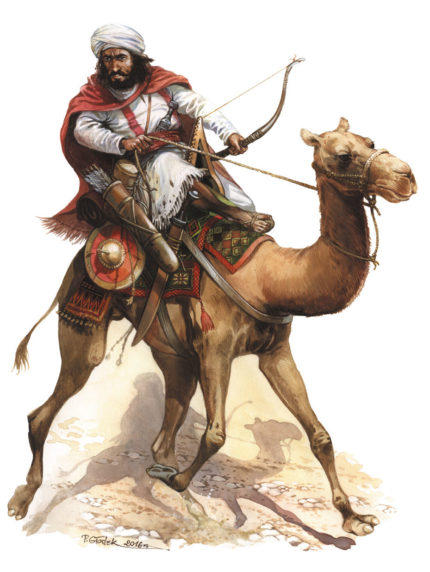
In a Sahīh Hadīth we see:
أَلَا إِنَّ الْقُوَّةَ الرَّمْيُ، أَلَا إِنَّ الْقُوَّةَ الرَّمْيُ، أَلَا إِنَّ الْقُوَّةَ الرَّمْيُ
…‘Indeed, strength is in archery. Indeed, strength is in archery. Indeed, strength is in archery.’ (Sahīh Muslim, 1917 – 167).
Muhammad owned 6 bows.
- Az-Zawra (Arabic: الزوراء)
- Ar-Rauha (Arabic: الروحاء)
- As-Safra (Arabic: الصفراء)
- Al-Bayda’ (Arabic: البيضاء)
- Al-Katum (Arabic: الكتوم): This bow broke during the Battle of Uhud and later was taken by Qatadah bin an-Nu’man
- As-Saddad (Arabic: السداد)
Archery & Indigenous Religion
There are several spiritual and/or religious connections to archery in serveral indigenous cultures. A thorough dive into all of them will remain outside the scope of this article. However we would suggest you look into the book on archery and the Lakota indigenous peoples by Joseph M. Marshall III.

Archery & Religion in Modern Times
After all this time, since the time of our caveman ancestors right up until this very day, there is still a connection between archery in religious ceremonies.
Interestingly enough, the National Head Coach of the US Olympic Archery Training Program, Kisik Lee (born 2 July 1957 in Seoul) has a religious approach to his archery teaching methods. He has attracted some scrutiny in 2008 after The New York Times reported some athletes felt uncomfortable with his strong advocacy of a religious lifestyle for the athletes at the Olympic Training Center.
According to the news article, Lee frequently held Bible study classes, encouraged his archers to sing hymns and attend church, and sponsored the baptisms of at least four archers, including Brady Ellison. [13]
In conclusion, archery and religion have been with us since the beginning and regardless of your personal beliefs or convictions neither is going away anytime soon.
Thank You For Reading & God Bless!
Sources
[1] “Lascaux cave: History”. www.karstworlds.com. Retrieved 26 November 2018
[2] Jean Clottes and David Lewis-Williams The Shamans of Prehistory: Trance and Magic in the Painted Caves
[3] Winkelman, Michael (2019-06-01). “Introduction: Evidence for entheogen use in prehistory and world religions”. Journal of Psychedelic Studies. 3 (2): 43–62. doi:10.1556/2054.2019.024
[4] National Treasure Sanjūsangen-dō. Kyoto. p. 30
[5] Guttmann, Allen; Thompson, Lee Austin (2001). Japanese sports: a history. University of Hawaii Press. p. 54. ISBN 0-8248-2464-4
[6] Selby, S., 2003, Chinese Archery, Hong Kong University Press, Hong Kong; J. Tian, J. Ma, 2014, The Way of Archery. A 1637 Chinese Military Training Manual, Schiffer, Atglen (PA)
[7] Chapters 1-4 of Selby, S., 2003, Chinese Archery
[8]Berger, Peter (February 15, 2012). “Is Confucianism a Religion?”. The American Interest. Archived from the original on August 17, 2015. Retrieved August 13, 2015
[9] http://www.univ-paris-diderot.fr/eacs-easl/DocumentsFCK/file/BOA14juin.pdf Archived 2016-06-10 at the Wayback Machine p. 1.
[10] Selby (2002—2003). Chinese Archery – An Unbroken Tradition?
[11] A. Moret, Du caractère religieux de la royauté pharaonique (Paris, 1902), pp. 105-6 (p. 106, n. 3: “II semble que cette cérémonie ait pour but de definir le pouvoir qu’a Pharaon-Horus de lancer, comme le soleil, ses rayons dans les quatre parties du monde”).
In the relief from Karnak (E. Lepsius, Denkmaler [Leipzig, 1850-59], III, Pl. 36b) Thothmes III is represented thus shooting, guided by Horus and Seth; in the late relief of the twenty-fifth dynasty (E. Prisse d’Avennes, Monuments égyptiens [Paris, 1847], Pl. XXXIII; H. Schafer, Agyptischer und heutiger Kunst und Weltgebaude der alten Agypter [Berlin, 1928], Abb., 54 and idem, “König Amenophis II als Meister-Schūtz,” Or. Literat. Zeitschr., [1929], col. 240-43) the queen is shooting at circular loaves, which are evidently symbols of the Four Quarters; the inscription states that she receives the bows of the North and South and that she shoots toward the Four Quarters; this is in the sed rite which, later in a reign, repeats the rites of enthronement and deification, apparently renewing the king’s royal power. This rite is accompanied by, or may perhaps replace another in which four birds are released to fly to the Four Quarters; bird and arrow are equivalent symbols
[12] http://www.studiesincomparativereligion.com/public/articles/The_Symbolism_of_Archery-by_Ananda_Coomaraswamy.aspx#_edn15
[13] Thomas, Katie (2008-08-25). “U.S. Archery Coach Fastens Religion to His Sport”. NYTimes.com. Retrieved 2012-11-08.
